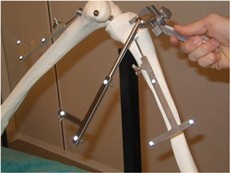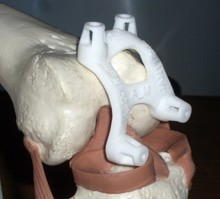
Computer assisted surgery
The goal of computer assisted surgery is to assist surgeons to operate with greater precision.
Its application has extended to a growing number of fields over the past 15 years. In the field of orthopedic surgery, its primary application is prosthetic surgery, particularly of the knee, where it aims to improve the reliability and accuracy of prosthesis implantation. The systems currently used are almost exclusively “passive systems,” which allow the surgeon to achieve the best possible position for the cutting templates, with the surgeon maintaining control over the procedure and performing the bone-shaping tasks.
There are two distinctive categories of passive systems:
- Perioperative systems. These are navigation systems. Infrared waves are emitted by the device and reflected by diodes fixed to the bone and instruments. Two cameras capture the reflected waves so as to provide real-time 3D positioning of the diodes attached to the bones and instruments During surgery, the surgeon receives computerized information relating to the anatomical region to be operated on, for example the knee, and the rotation centers of the lower limb. Once this acquisition is made, he will be able to precisely choose the bone cutting axis. The system will show him how to best position the cutting templates in order to perform the selected program. These systems require programming during the surgical procedure, which moderately extends the operative time.
Preoperative systems. The latest systems require a scanner or preoperative MRI, enabling acquisition of the knee and entire lower limb, for which the surgeon will choose cutting and prosthetic implantation axes. Cutting templates specific to the patient are made. During surgery, they are applied to the joint extremities (for a knee, the femur inferior extremity and the tibia superior extremity). This allows the surgical intervention to be performed with great precision according to the pre-surgical planning based on MRI or scanner data. This is the most recent technique, and 4 to 5 weeks are necessary to prepare tailor-make material for the patient. However, when using this technique, operative time and bleeding are decreased, as compared to standard procedures or navigation systems
While preoperative systems are increasingly used, the standard procedure is still considered to be valid and efficacious.

 Preoperative systems. The latest systems require a scanner or preoperative MRI, enabling acquisition of the knee and entire lower limb, for which the surgeon will choose cutting and prosthetic implantation axes. Cutting templates specific to the patient are made. During surgery, they are applied to the joint extremities (for a knee, the femur inferior extremity and the tibia superior extremity). This allows the surgical intervention to be performed with great precision according to the pre-surgical planning based on MRI or scanner data. This is the most recent technique, and 4 to 5 weeks are necessary to prepare tailor-make material for the patient. However, when using this technique, operative time and bleeding are decreased, as compared to standard procedures or navigation systems
Preoperative systems. The latest systems require a scanner or preoperative MRI, enabling acquisition of the knee and entire lower limb, for which the surgeon will choose cutting and prosthetic implantation axes. Cutting templates specific to the patient are made. During surgery, they are applied to the joint extremities (for a knee, the femur inferior extremity and the tibia superior extremity). This allows the surgical intervention to be performed with great precision according to the pre-surgical planning based on MRI or scanner data. This is the most recent technique, and 4 to 5 weeks are necessary to prepare tailor-make material for the patient. However, when using this technique, operative time and bleeding are decreased, as compared to standard procedures or navigation systems